A merchant by day, a hero by night. Moonlighter, developed by Digital Sun, is an action RPG with rouge-lite elements that lets you play as young merchant Will, who has to run his store by day. But at night he fulfills his dreams of becoming a hero by venturing into ever-changing mysterious dungeons, slaying monsters, and bringing back valuable loot to put on display when he has to open the store again in the morning.
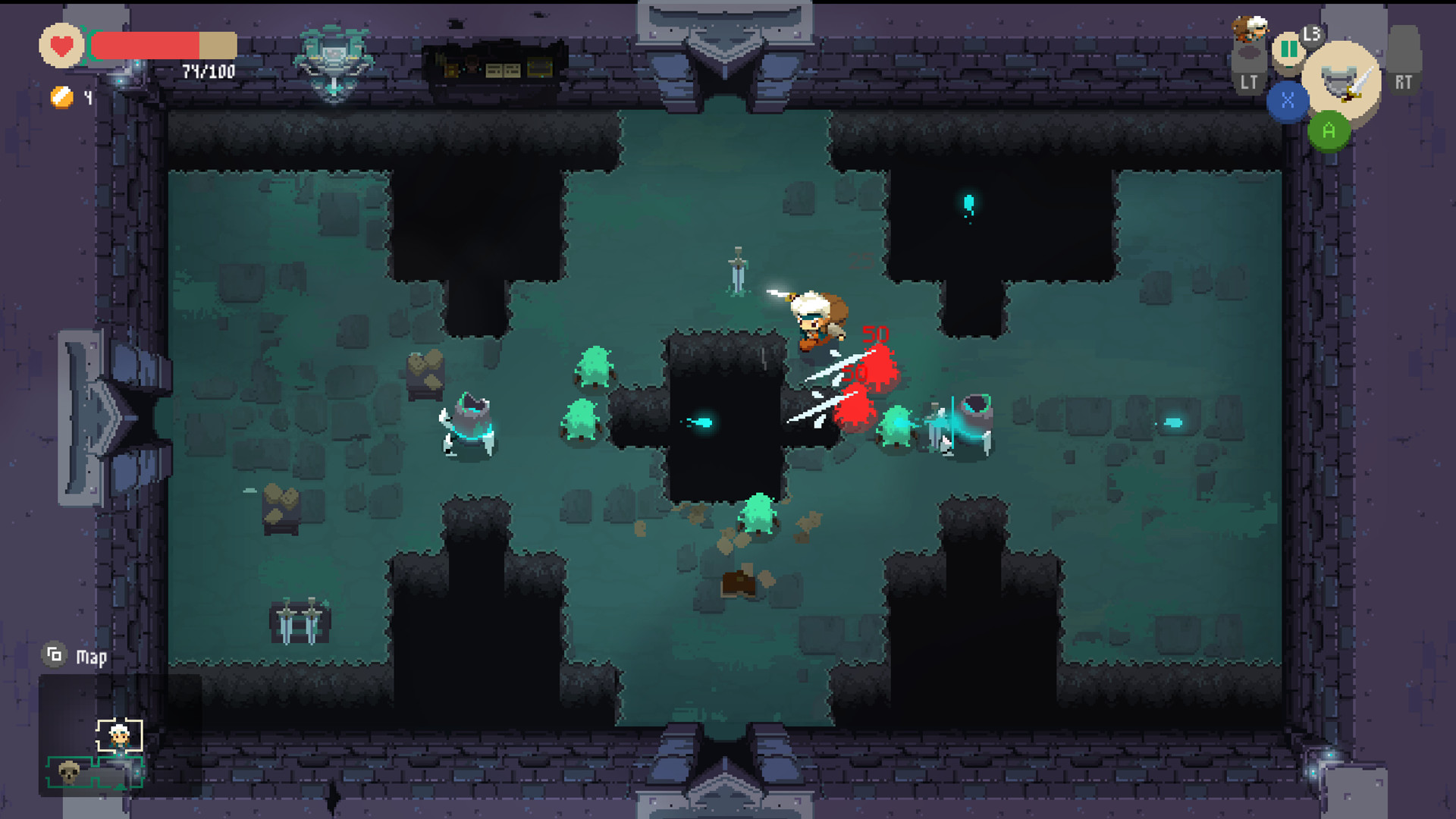
The Moonlighter is the name of the store that our main character inherits and has to run. But more than shopkeeping, Will is interested in a set of mysterious doors found in excavations behind the village where he lives. The doors lead to other worlds and those who enter find a different dungeon each time, filled with monsters, traps, and rare artifacts. Will roams these dungeons with a huge backpack on his back, trying to fill it with the most valuable things he could sell in his store the next day. The gameplay is therefore separated into two very distinct parts. At night, you go into dungeons, fight monsters, try to get as far as possible, and manage your inventory so you can fit in as many valuables as possible. During the day you then open your store and have to figure out from the reactions of your customers, at what price you can sell the loot you brought back.
Time to Fight
When you first visit the excavation, only one door out of five is accessible. You can enter the Golem Dungeon, the other doors are sealed and will only open when the boss of the previous area is defeated. Each dungeon consists of three floors with progressively stronger monsters, between each floor is a mini-boss, and at the end is a main boss. In the first area, it’s the Golem King. But it will probably take you quite a long time before you even see the King, let alone defeat him.
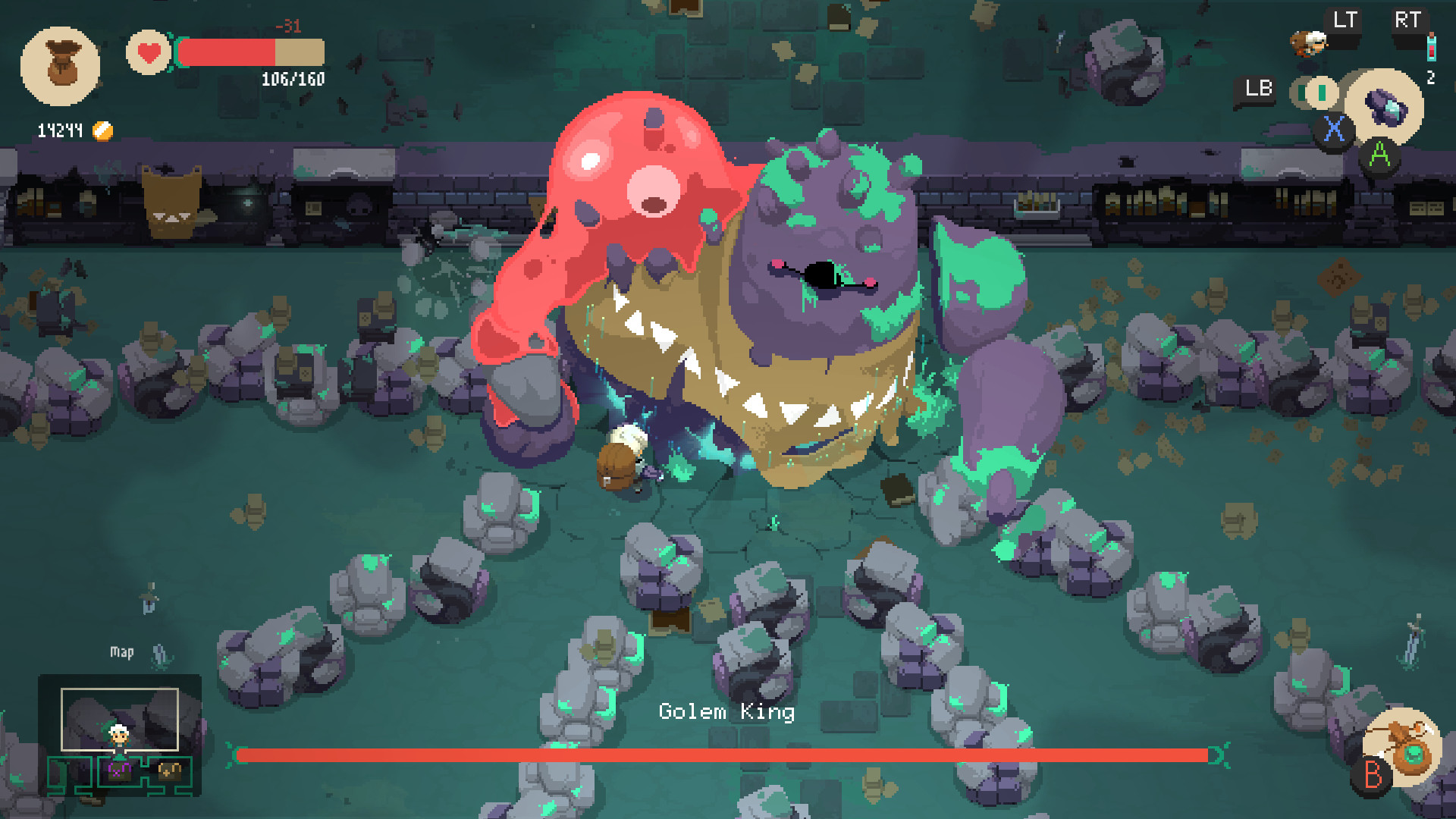
You will start with just an old sword and shield, no armor. As you bring materials and artifacts from the dungeon, you will be able to craft better gear. But your most useful weapon is available right from the start – the dodge roll. You basically can’t get anywhere in this game without mastering it, not just because you need to evade enemy attacks, but also because there are traps and holes in the floor that you need to overcome. Fighting is pretty straightforward in Moonlighter, you don’t learn any new skills, and the only way how your character is progressing is by crafting better equipment or mixing and matching weapons to change your fighting style. For example, the best fit for me was a spear that has further reach than most weapons so I can keep my distance from the enemies and wearing armor centered around speed and mobility, only the chest piece is from a heavier set to provide a bit more protection. You can also carry two rings with some passive abilities, like the ability to resist shock attack, but the rings are a rather rare drop in the dungeons so you can’t plan your build around them.
Run or Gun
Right at the start of the game, you get a special amulet, that allows you to teleport outside of the dungeon, with your inventory intact, and end your run. If you don’t do this and you get knocked out by a monster, you will wake up outside with only up to five things in your pocket, the whole content of your backpack will be lost and all the progress in the dungeon will be gone too. So especially at the beginning stages of the game you really need to balance your chances of survival in the next part of the dungeon against the loot you already managed to get. Some rooms that you enter will close the doors behind you and won’t allow you to exit until you clear all the enemies. The amulet takes some time to activate so you have to think in advance, whether it’s worth it pushing forward or if it’s better to get out with your loot while you still can.
The unique inventory system in Moonlighter can make these decisions easier, but also more difficult at the same time. When you first start collecting loot, everything seems plain and simple, the items stack to a certain degree, when your inventory is full, you’re done or you have to discard less valuable items to get more valuable ones. But as you progress further through the dungeons, things start to get more complicated. Many items that you find will be cursed and the curse affects where you can place the item in the inventory. In the beginning, you will encounter relatively simple curses like one that only lets you place the item at the top or at the bottom of the inventory. Later there are curses that for example transform the neighboring item into a copy of itself or even destroy it. So every opening of a treasure chest comes with a little puzzle where you try to perfectly place the most valuable items into an inventory and not lose anything to the curses. Sometimes you’re lucky and find items with modifiers that are actually helpful, like teleporting a stack of items in a certain direction straight to the store. This can help you prolong your run without risking the most valuable loot. But at least at the beginning, it’s better to play it safe and get back with materials for upgrades and enough loot to fill the shelves in your store.
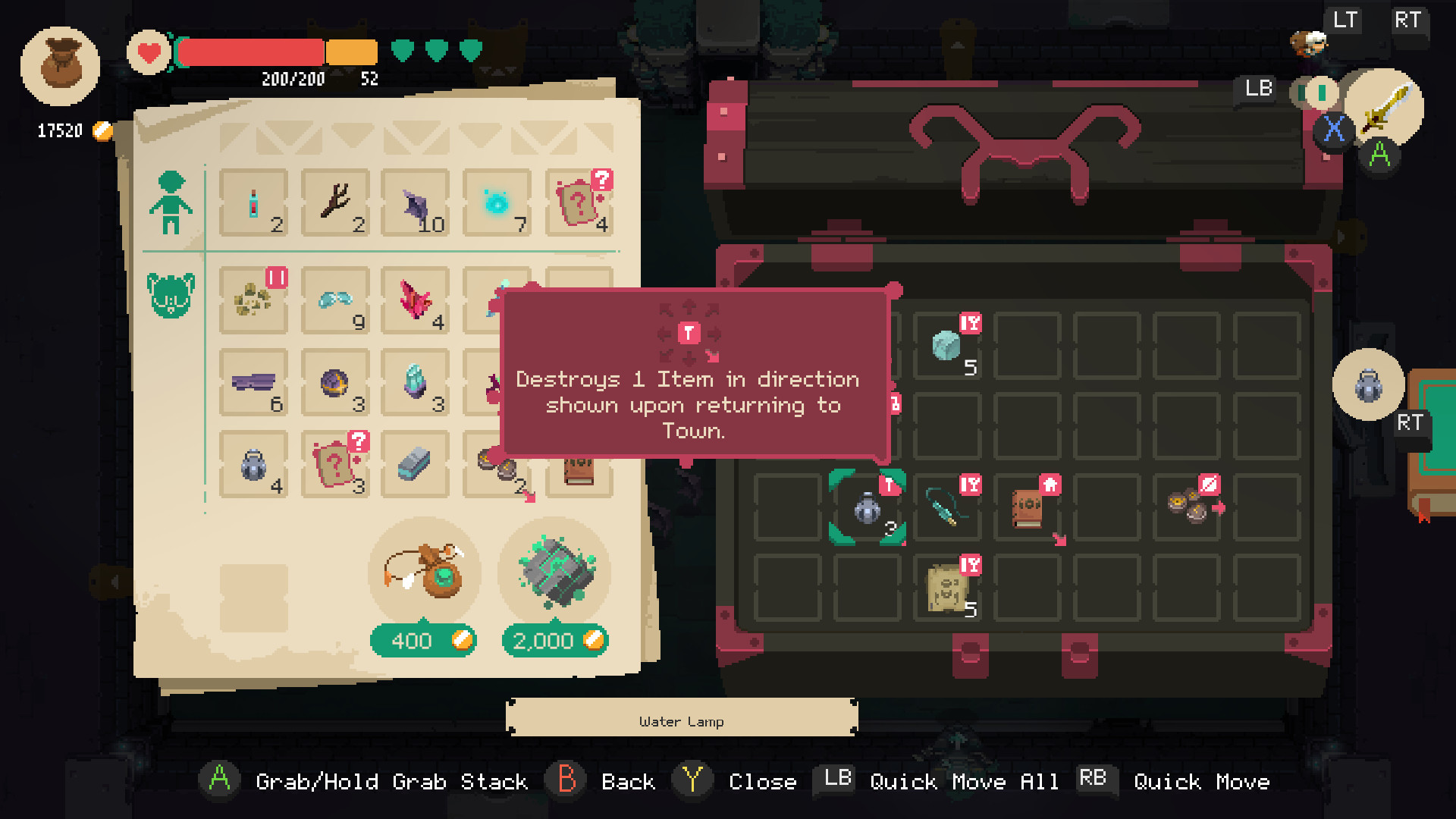
Time to Trade
When you decide to leave the dungeon, it’s time to sell the loot. The only catch is, that you have no idea how much everything costs. There comes another part of the game, where you put an item on the display, you have to guess the price, and then watch customers react to the price you set. If the price is too high, they will look angry, if it’s just right, they will be happy and usually pick it up and take it to the cashier’s desk where you take the money from them. And if the price is too low, the customer will get very excited and you will get very sad, because you have to sell them the item for the low price once they have picked it up. With valuable loot from boss fights it’s a bit of a nerve-wracking process since you only get the items once, you cannot repeat a boss fight once you defeated the boss at the end of a dungeon.
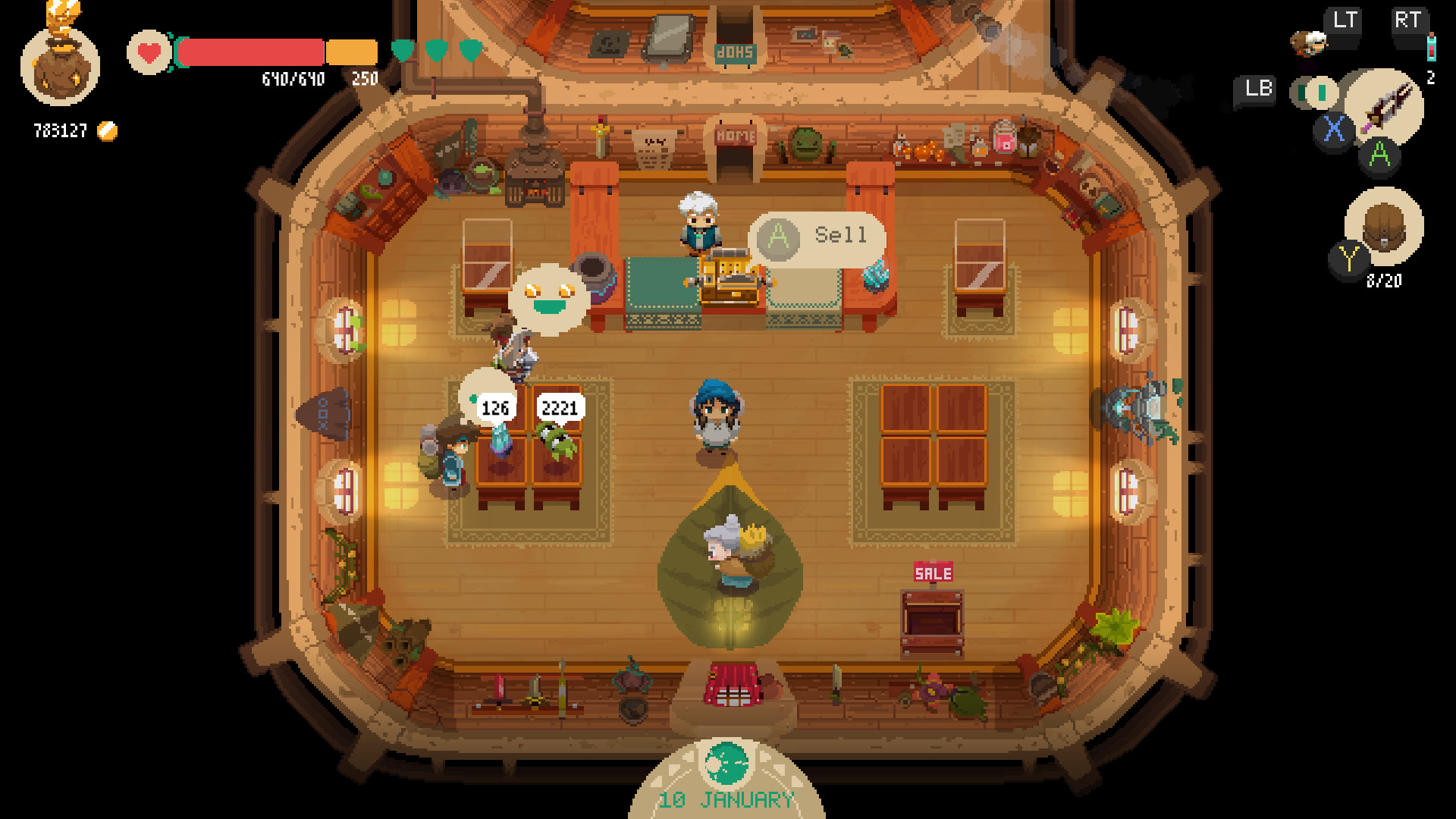
The prices of each item will be logged in Wills diary so you don’t have to remember a bunch of numbers, you just have to figure out the optimal price. There is also a mechanic of low and high demand where the value of items gets slightly changed, but once I got more comfortable with the game and was able to bring in enough valuable loot, I started to ignore these price changes and simply sold the items for their base value.
The money earned by trading can be used in several ways. The most important way to spend your hard-earned money is by investing in the Rynoka village. The village is mostly empty when you start playing, but investing some money can attract more people and other traders. The first one will be the blacksmith who helps Will to upgrade his gear. The blacksmith needs not only payment but also materials, with higher tier gear requiring materials from higher level dungeons, so you can never get the top armor and weapons without progressing further in the dungeons. More investments can bring into the village merchants with healing potions, (overpriced) crafting materials, a banker, and a merchant with store decorations. This takes us to the last area of investment – The Moonlighter itself. You can purchase an increased size of the store and various upgrades that will make people leave bigger tips, increase protection against thieves or even give Will a health boost for his next trip to the dungeons.
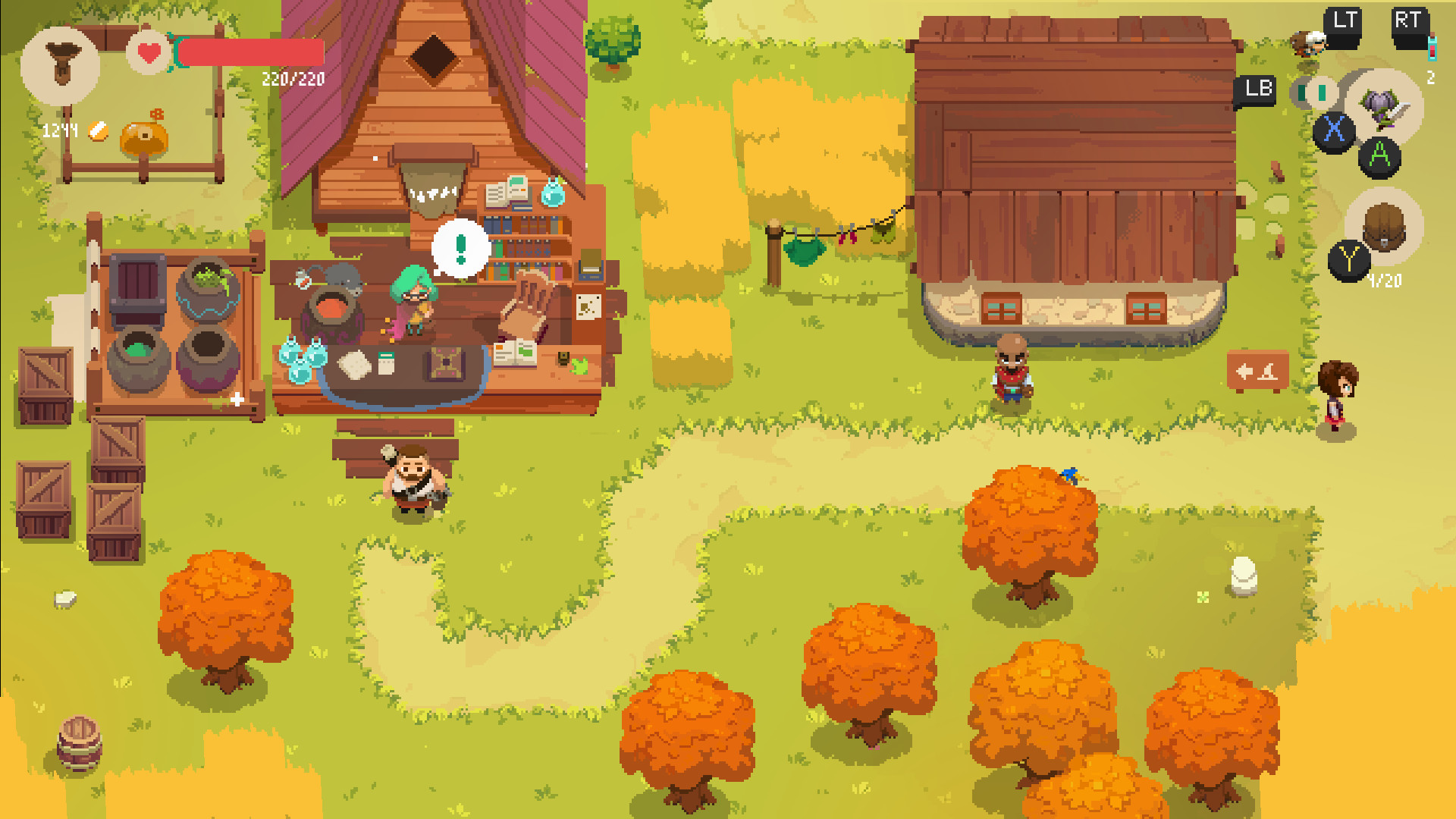
Rinse and Repeat
If you’re not a fan of the trading part, you can sort of skip it by hiring a shop assistant in the later stages of the game. But the core gameplay loop stays the same – Enter the dungeon, get as much loot as possible, go back to sell it, upgrade (if you can), and back to the dungeon. The mechanics of the game are relatively simple, but some fights are still challenging, so I found the Moonlighter to be a nice mix of being able to relax my brain but still needing to use my reflexes. Though I could also see the game being potentially frustrating and very repetitive if someone does not manage to progress to the next dungeon quickly enough. I would say it’s a great game for handheld consoles, where you can pick the game up while traveling and not be confused about what’s going on if you continue much later. And the pixel art looks awesome on any system. But for a PC game, I miss a bit more complexity, especially in character development, the combat does not really change with no skills available. Also on PC, devs made some rather strange choices when it comes to controls, so a controller is highly recommended.


